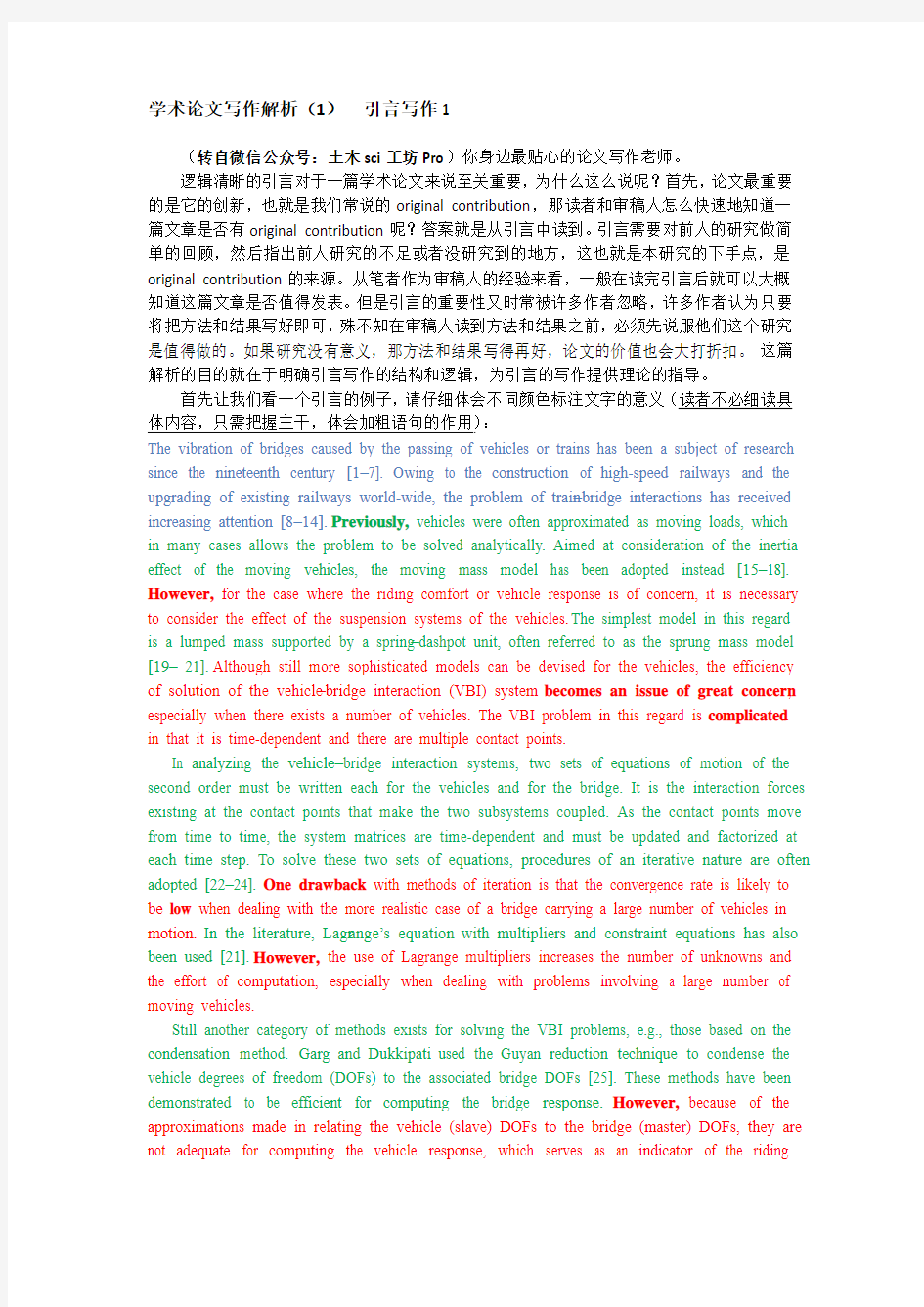学术论文写作解析(1)—引言写作宏观逻辑

- 1、下载文档前请自行甄别文档内容的完整性,平台不提供额外的编辑、内容补充、找答案等附加服务。
- 2、"仅部分预览"的文档,不可在线预览部分如存在完整性等问题,可反馈申请退款(可完整预览的文档不适用该条件!)。
- 3、如文档侵犯您的权益,请联系客服反馈,我们会尽快为您处理(人工客服工作时间:9:00-18:30)。
学术论文写作解析(1)—引言写作1
(转自微信公众号:土木sci工坊Pro)你身边最贴心的论文写作老师。
逻辑清晰的引言对于一篇学术论文来说至关重要,为什么这么说呢?首先,论文最重要的是它的创新,也就是我们常说的original contribution,那读者和审稿人怎么快速地知道一篇文章是否有original contribution呢?答案就是从引言中读到。引言需要对前人的研究做简单的回顾,然后指出前人研究的不足或者没研究到的地方,这也就是本研究的下手点,是original contribution的来源。从笔者作为审稿人的经验来看,一般在读完引言后就可以大概知道这篇文章是否值得发表。但是引言的重要性又时常被许多作者忽略,许多作者认为只要将把方法和结果写好即可,殊不知在审稿人读到方法和结果之前,必须先说服他们这个研究是值得做的。如果研究没有意义,那方法和结果写得再好,论文的价值也会大打折扣。这篇解析的目的就在于明确引言写作的结构和逻辑,为引言的写作提供理论的指导。
首先让我们看一个引言的例子,请仔细体会不同颜色标注文字的意义(读者不必细读具体内容,只需把握主干,体会加粗语句的作用):
The vibration of bridges caused by the passing of vehicles or trains has been a subject of research since the nineteenth century [1–7]. Owing to the construction of high-speed railways and the upgrading of existing railways world-wide, the problem of train–bridge interactions has received increasing attention [8–14].Previously, vehicles were often approximated as moving loads, which in many cases allows the problem to be solved analytically. Aimed at consideration of the inertia effect of the moving vehicles, the moving mass model has been adopted instead [15–18]. However, for the case where the riding comfort or vehicle response is of concern, it is necessary to consider the effect of the suspension systems of the vehicles.The simplest model in this regard is a lumped mass supported by a spring–dashpot unit, often referred to as the sprung mass model [19– 21].Although still more sophisticated models can be devised for the vehicles, the efficiency of solution of the vehicle–bridge interaction (VBI) system becomes an issue of great concern, especially when there exists a number of vehicles. The VBI problem in this regard is complicated in that it is time-dependent and there are multiple contact points.
In analyzing the vehicle–bridge interaction systems, two sets of equations of motion of the second order must be written each for the vehicles and for the bridge. It is the interaction forces existing at the contact points that make the two subsystems coupled. As the contact points move from time to time, the system matrices are time-dependent and must be updated and factorized at each time step. To solve these two sets of equations, procedures of an iterative nature are often adopted [22–24]. One drawback with methods of iteration is that the convergence rate is likely to be low when dealing with the more realistic case of a bridge carrying a large number of vehicles in motion.In the literature, Lagr ange’s equation with multipliers and constraint equations has also been used [21].However, the use of Lagrange multipliers increases the number of unknowns and the effort of computation, especially when dealing with problems involving a large number of moving vehicles.
Still another category of methods exists for solving the VBI problems, e.g., those based on the condensation method. Garg and Dukkipati used the Guyan reduction technique to condense the vehicle degrees of freedom (DOFs) to the associated bridge DOFs [25]. These methods have been demonstrated to be efficient for computing the bridge response.However,because of the approximations made in relating the vehicle (slave) DOFs to the bridge (master) DOFs, they are not adequate for computing the vehicle response, which serves as an indicator of the riding
